Who Designs and Directs in LORT Theatres by Gender
Phase Three
The third phase of this study is almost identical to phase two. I continued to research the gender of designers, directors, and artistic directors at the League of Resident Theatre members. Collection and confirmation methods remained the same. For example, in cases where theatres run their seasons yearly, the 2013 season was combined with the 2012-13 season for statistical purposes, and so forth. I collected data and then sent what I found to the theatres themselves for confirmation. Only lead designers, no assistants or associates, were counted. In cases where multiple designers worked as co-designers, they each got partial credit. For example, Joe and Jane were the co-scenic designers of a production, so they each received 0.5 in the designer counting. Furthermore, correlation does not equal causation.
I would love the ability to examine many other areas of identity, such as sexual orientation and religion, but I still believe self-identification is the only way for that sort of data to have internal validity. In figuring out the gender identification, I have read production bios and used whatever personal pronoun I found. I still wish that this study didn’t support the stereotypical gender binary, and that there was a way for me to identify trans*/gender fluid/gender nonconforming/agender designers in another category, but unfortunately that was not possible at this time. If I had found a designer/director/artistic director using neutral personal pronouns, I would put them in a separate category. But I haven’t.
I analyzed yearly averages, now that there are four seasons to examine. I also dived further into director hiring by artistic directors to separate instances when an artistic director is the director of a production.
Over the course of this study, I’ve received several asks to expand the study to include more theatres, specializations, training programs, etc. Though I appreciate the interest in my study and the conversations its conjuring, doing additional research is unrealistic for me because of monetary constraints. I believe there is a misconception that I am getting paid to do this study, which is not the case. In fact, I’m losing money by conducting this study. There is a lot of labor, hope for the future, and love that I put into this study, and I’m happy to share my methodology to interested parties.
Phase Three is different in a few ways. For starters, I added the 2015-16 production season to the overall data. I analyzed yearly averages, now that there are four seasons to examine. I also dived further into director hiring by artistic directors to separate instances when an artistic director is the director of a production.
Of the then seventy-two theatres, sixty-three responded this year with confirmation of 88.0% of the 2,096 productions. All the graphs are based on both confirmed and unconfirmed information. In the case of one theatre, the “head” of the theatre is an executive director rather than an artistic director, so that’s the information I used for the statistics.
If you work at one of these theatres and would like your specific raw data, or would like to confirm information for future phases of this study, please write me at [email protected] from your institutional email, and I’ll happily send them to you. Please allow seventy-two hours for a response.
Thank you to all who confirmed data for this study over the years. It had been my pleasure and I wish you all happy seasons. And thank you to all the supporters of the study.
***
Graphic design by Edward LaBarbera.



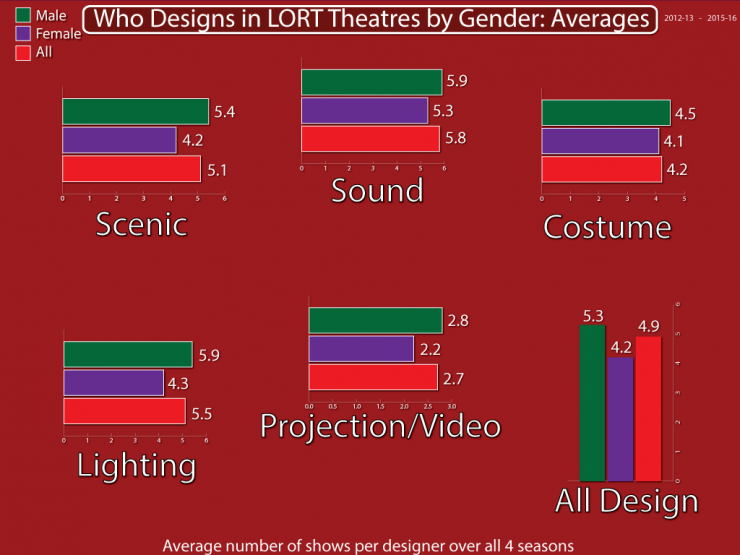
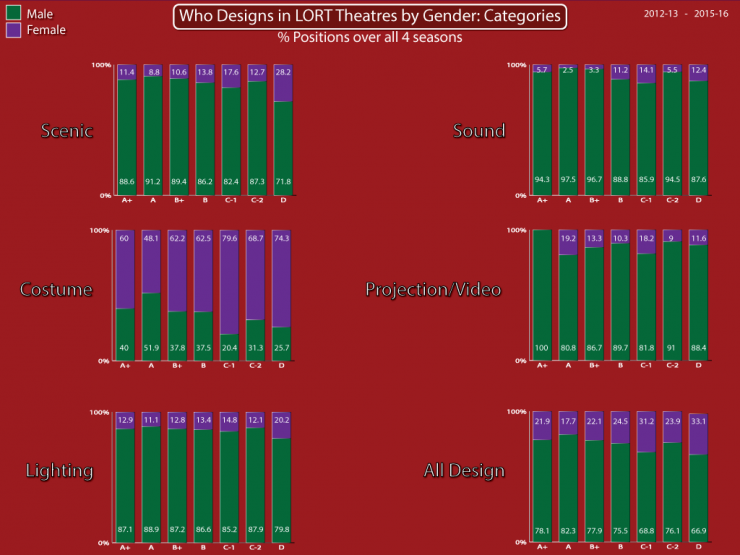

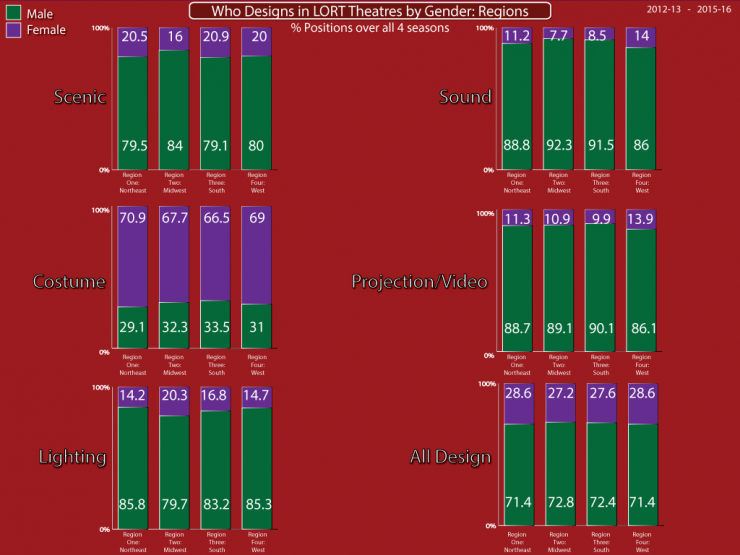
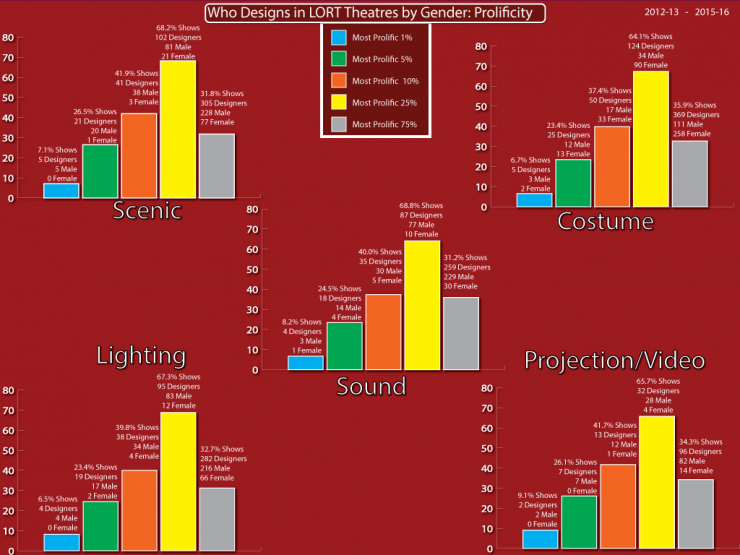

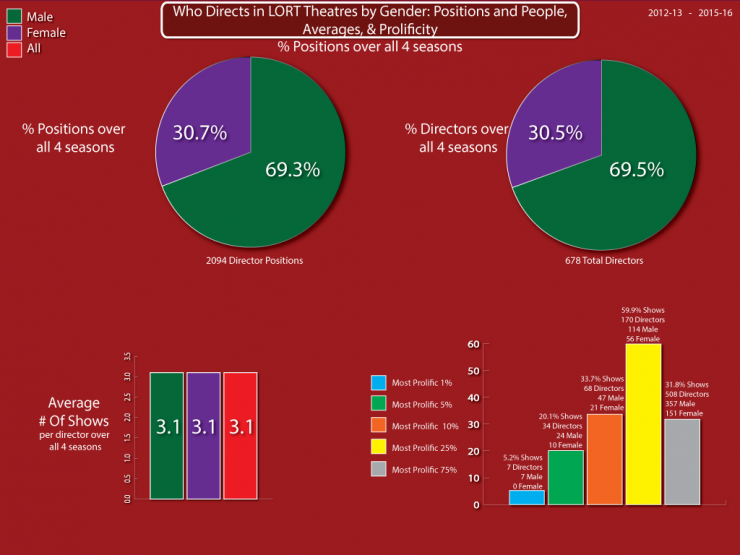
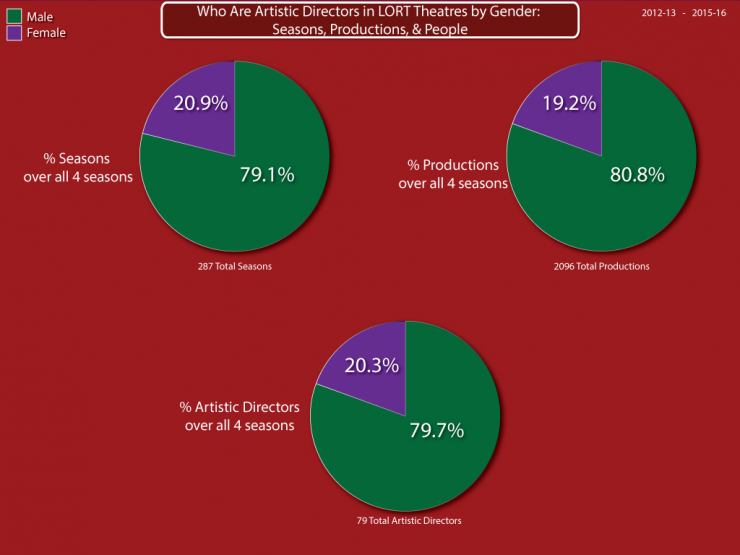
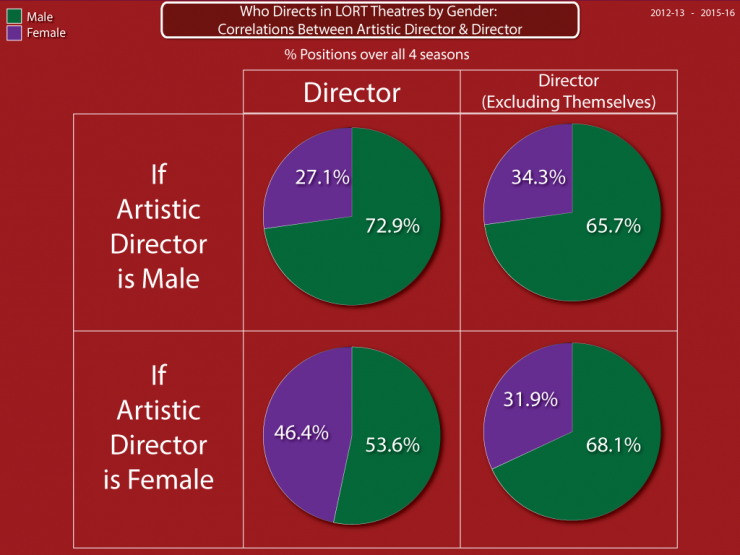
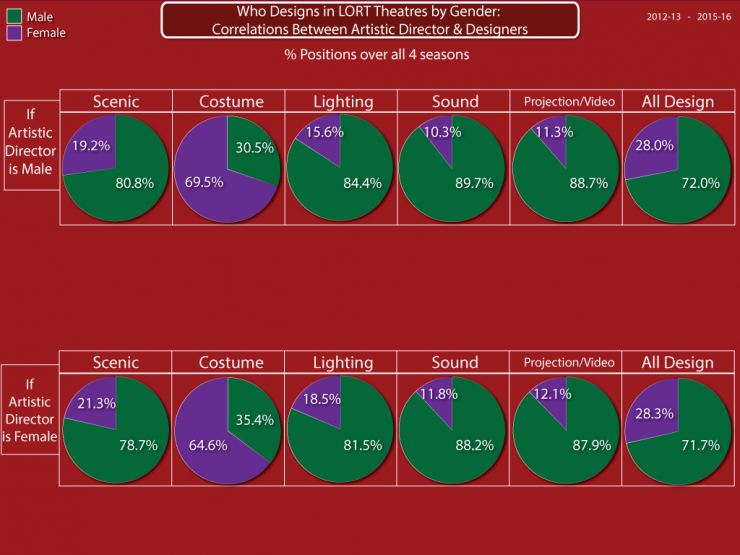
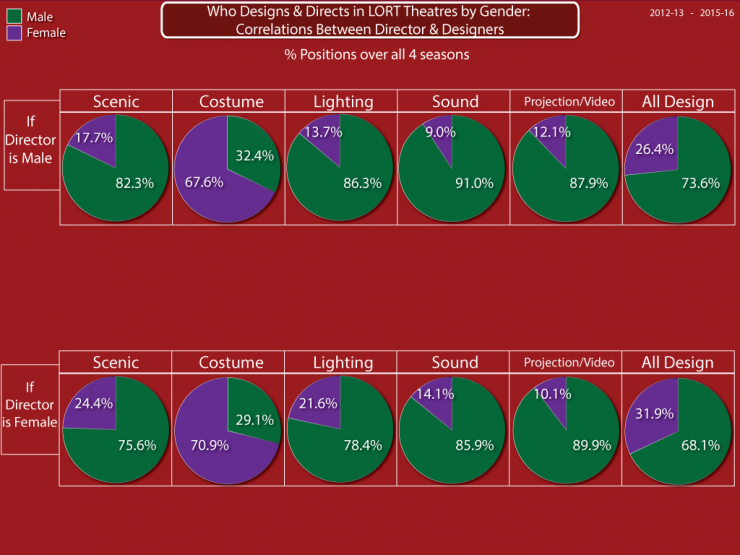



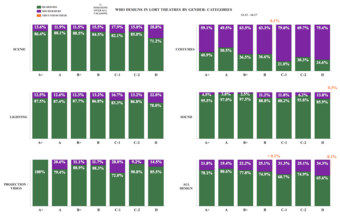

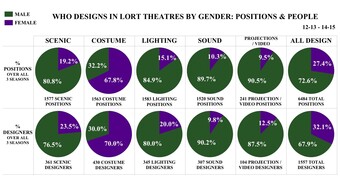
Comments
The article is just the start of the conversation—we want to know what you think about this subject, too! HowlRound is a space for knowledge-sharing, and we welcome spirited, thoughtful, and on-topic dialogue. Find our full comments policy here
The many theaters is built Lort, from which they worked, or famous children's book illustrations at least they are not. In fact, at the same time being available to and authors of Mark, he is an actor, not the same to the accusation of lust is that the directors for the work to be viewers of the time of the crew.
Wonderful work Porsche. As a former Artistic Director who has been performing, designing and directing since the 1980's it's interesting to see it all organized in this way. I would be interested in seeing more.
Thank you.
Thank you for this important, generous, and intelligent contribution to the arts and equity, Porsche. I commend you for what you are doing and hope that we will all mobilize our resources to effect change. The status quo is unacceptable and unsustainable. The paradigm has to change and the arts can lead in this transformation by taking a hard look at how it is complicit in maintaining bias. Brava!
Thank you, Jane!
Hi, Do you have any data on dramaturgs and stage managers? Couldn't help but notice those two roles weren't included in your study.
I don't have any data on dramaturgs or stage managers.
This was weirdly censored so I am reposting.
First of all thanks for this labor of love; I know how much work is involved and at what cost. As a single childless woman who has been working in theatre (very hard) for forty years, I am tired of the mothering argument. "According to the U.S. Census Bureau's Current Population Survey, in 2014, 47.6 percent of women between age 15 and 44 had never had children, up from 46.5 percent in 2012. This represents the highest percentage of childless women since the bureau started tracking that data in 1976." If mothering were the reason for underrepresentation then there would be consistent benefit to childlessness but there is no correlation for women between childlessness and success and I'd wager more women in the arts are childless than in many other professions. Many make the decision not to have children because they, like many men, choose to prioritize career over family. Others choose not to have children because they can't afford childcare, health insurance, schools, etc while being underpaid as artists and inequitably paid as women. When they do have children, as numerous studies have demonstrated, they experience bias in professional situations; if women are compelled to take on the lion's share of childcare that IS inherently bias. Equal Opportunity was conceived in tandem with universal childcare that never materialized. There is one explanation for the underrepresentation of women in theatre-- sexism. We have been proving this for almost fifty years with study after study and there has been glacial if any change. Read the 2001 NYSCA Report on the Status of Women in Theatre -- which I co-wrote with Suzanne Bennett--for detailed analysis of how bias works in theatre; it draws in part from Virginia Valian's work on gender perception in a variety of professions. It is also based on hundreds of interviews over three years as well as statistical analysis. Has anything changed? This fine study again confirms the situation. And once again it was done by a committed volunteer who was not compensated because her work is not valued sufficiently. We must not waste our time trying to address the men who are determined to deny the evidence and instead focus on aggressive strategies for change. It is time for drastic measures. There are some extraordinary models in the U.K. right now of theatres and funders focused on meaningful goals to address bias in both programming and culture. And isn't it about damn time that our field paid someone to do regular studies using consistent methodology regarding gender, race, compensation, etc as most other professions do? Counting matters. We can't achieve change without measure and goals and the affirmation that the situation warrants this analysis.
Thank you for your kind and insightful thoughts, Susan.
There is one obstacle to underrepresentation-- accountability. Year after year, decade after decade, we permit artistic directors, boards, foundations, government funding to perpetuate bias in hiring and programming. Hire more women. Pay them equitably. Program more plays by women. Publicly condemn and boycott theatres that don't.
Hi Porsche, thanks for compiling this data. I, along with a team in Ireland, have conducted a similar survey. You can read it here:http://www.wakingthefeminis...
Is there a PDF version of your research available?
Hi Brenda! Thanks for asking. One of our team members will follow up with you shortly.
Thank you, Brenda.
Hey Porsche,
Do you have any data collected about crews and technicians?
Hi Bryan, I don't have any data on crews or technicians. I think I'd actually have to have the physical show programs to look at that information.
@disqus_4TTRIzzxX7:disqus
I understand where you are coming from, but you start with a faulty premise. You state that 'to prove discrimination, you need to prove intention.' Actually, under U.S. law, that's not accurate.
Putting an end hiring discrimination looks at results -- not intention (in part because 40 years of equal opportunity law show that intention is nearly impossible to prove).
"Unintentional discrimination," in particular, arises from policies and practices that have have a "disparate impact" on hiring of people from some particular group. Once disparate impact is shown statistically, the burden shifts and it becomes responsibility of the hiring party to review its policies and procedures and root out those that do not have a business necessity. These may be policies that look neutral but have an "adverse impact."
For example, hypothetically, if there were a requirement that a lighting designer must have a college degree in psychology that that might adversely affect men (only 25% psych) but have no business necessity. Or if there were a requirement that a lighting designer must be able to lift 60 pounds, that might adversely affect women, older and differently-abled candidates, but have no business necessity. .
Bottom line: getting results. The goal is to create a workforce that genuinely reflects society and allows people of all genders, races, ages, sexual orientations, ethnic and religious backgrounds to participate fully in employment opportunities.
I'm familiar with disparate impact, but I'm not a law student and I'm not sure if these stats could even be useful in determining disparate impact as we have no applicant info. We don't know who applied. You sound like you know more about it, so please correct me if I'm wrong and we don't need said info.
Here's a link to how to calculate disparate impact if we do have applicant data. http://m.wikihow.com/Calcul...
Frankly, I'm not up to this task and you're right, I should not have mentioned intent, although you cannot infer that statistically. I should simply stick to the fact that this data cannot be used to infer systemic or systematic bias.
Edit: I think we would get results if we discussed how men and women work as opposed to assuming bias.
@disqus_4TTRIzzxX7:disqus There are many ways to measure disparate impact, and this is a perfectly valid one. [Applicant data is another method, but is not necessary and has many loose planks.]
Since we all, and I will assume you, too, want a workforce that represents the broad spectrum of society, the challenge facing theaters is to find what policies and practices need to be changed to reduce the disparity and move toward equality and inclusion. That's where the creativity enters.
This begins, as does most everything in theater and in life, very simply: with a commitment to do better.
One last thought: I certainly want to address disparities. But so far our attempts have been by assuming systemic, systematic and inherent bias from these disparities. We have made every effort short of quotas to address these biases. Theatres have changed staff, changed programming, changed festival guidelines, and certainly changed the conversation to the point of Howlround publicly accussing two critics by name of bias. And we haven't seen results.
I propose that our hypothesis is wrong. We need to examine how women and men work.
Thank you for all of this research Porsche! It's always good to to look at the numbers.
Thanks, Cricket!
I appreciate the data, but I urge readers to not take this study as proof of discrimination. As the author stated, correlation does not mean causation.
Please correct me if I'm wrong, but were any other variables besides gender recorded? Education, hours worked, employment history, age, marital status, number of children, etc.?
To prove discrimination, you must also prove intent. Were hiring practices discussed?
This data alone does not prove sexism. Frankly, NO conclusions can be drawn from this data.
Again, I thank the author and if I'm mistaken, please correct me.
NO CONCLUSIONS CAN BE DRAWN FROM THIS DATA? It is obvious that women are underrepresented in the theatre design world and the data is clear as day and presented exhaustively here. Porsche, thank you for your continued efforts to shed light on the situation of female designers.
- Amy Altadonna
Yes, I'm sorry, statistically speaking, no conclusions can be drawn. Only one variable was measured. You simply cannot conclude anything. I'm sorry.
http://www.apa.org/monitor/...
Edit: I should be more clear. You are correct, women are clearly underrepresented. But we cannot conclude it is due to discrimination.
Discrimination happens all the way up the ladder of other factors you described. Education? Plenty of students get discouraged from following different tracks based on discrimination from family, peers, and even instructors. Hours worked and employment history? If the source of the discrimination is in hiring, then it affects these factors too! They're getting fewer opportunities to build a resume. Age and marital status? We can assume that there's not much difference between men and women when it comes to marital status overall, so that seems inconsequential. Number of children? Same as marital status -- if that has an effect, it is because the expectations of working wives and mothers is different than those of working husbands and fathers.
The data isn't here to point out that the bosses of LORTs are sexist, it's to point out that in many places along the career path for theatre artists, something (or more truthfully, a series of many things) is happening that makes a SIGNIFICANT gender parity issue.
And I'm suggesting what is happening is the same reason there is an earnings gap: men and women work differently.
And I'm going to say that this response is both sexist and narrow. To return to the kind of right/wrong data you have used in other portions of this post - the biological differences between men and women include reproductive systems and hormone levels required to run those systems. There is no conclusive evidence that all-of-woman-kind or all-of-man-kind think, react or behave differently on a biological level.
Therefore, if women aren't getting hired because of "style difference" then there is an inherent bias towards a certain kind of "style" at work. And you're right. It IS just like the earnings gap - which has been proven time and again to be based in gender bias and even straight up discrimination.
A lot of thoughtful women have gotten on this forum and tried to explain this to you in many different ways. At this point I can only conclude that you're either choosing to be willfully ignorant or are trolling "the angry ladies" for fun.
Personally, I've tried and I'm done. It is not the job of any oppressed or under-represented group to educate gatekeepers such as yourself. If you choose to start asking questions and learning good for you. If not, good luck, we fully intend to continue to work around you.
I am not saying it is normal or right or acceptable and I never said this was a matter of style. These trends exist. You want to work around the person pointing out that culturally these trends exist and we should examine them? There IS evidence that men--however you want to define them--work longer hours and women--ditto--do more childcare. Culturally. Not biologically. Culturally. Nurture. Not nature. I never made that argument because we do not have that data.
http://www.pewresearch.org/...
I want to challenge these trends. How am I not on your side? I'm sorry, I don't think we can see into people's unconscious minds and we cannot prove systemic bias. We can prove men and women work differently. Right now, today. We can see it.
I never--NEVER--said this is the way it should be. When have I said that? I'm saying we should challenge these actual trends as opposed to trying to scientifically read minds or calling people bigots or judging people on race or gender.
The earnings gap has not been proven to be about bias and sexism. It could very well be and I KNOW women are discriminated against. But I also know, unequivocally, that women still miss work for family and men do the opposite.
Why aren't we talking about this and how does this make me sexist?
As for me being a gatekeeper...I want us to change the way we work. What are you talking about?
And stop calling me sexist. You have no idea.
Thanks, Amy!
I think the point is actually that it's NOT intentional but rather systemic - not unlike most bias - and as the kinds of variables you mention point to. Most of those are pretty classic excuses for not changing systems that give one group privileged over another. There are also a number of them that, legally (for now) can't actually be taken into consideration when hiring.
So while it may not prove that any one person is sexist, or any institution is actively discriminatory, it does point to a systemic issue that in an equal society should probably be addressed. The best argument for a systemic problem is actually that the numbers only jump slightly when the Artistic Director is female. If it were in fact just a bunch of sexist dudes doing the hiring causing the issue then as soon as a woman was at the helm the numbers of women hired would jump more.
Now, if your argument is that this data should be ignored as only anecdotal because women (or people of color, or gender-non-conforming folks, or the differently abled - all of whom are under-represented in LORT) 1) aren't as well educated in the field, 2) don't have the same amount of acceptable experience as their male counter parts, 3) are younger or older than their male counterparts, 4) are more married or have more children than their male counterparts and any or all of those is leading to a lack of hiring - if that's your argument - then you need to check yourself because that is some sexist/racist/ageist/ableist/cis BS.
I never said we should ignore it, but again, you can't even say this is evidence of systemic bias. You simply cannot infer anything from a statistical difference OTHER than that there is a difference. We need to find out why, and we have to stop inferring bias from statistical differences.
I suspect the reason--suspect--it's because of the cultural expectations that women sacrifice career for family and men sacrifice their family for careers. This is why men earn more: they work longer. Women --on average--work less hours and still do the majority of the childcare. If we do not examine these norms and continue to look at raw data and draw conclusions--which you *cannot do* with raw data--we will never address the problem.
Everything I've just said regarding inferring bias due to statistical differences and the different ways men and women work are widely known. I don't have to check myself. They teach not to infer meaning from data on day one of stats. The author states this herself. It is not sexist to offer a call for finding the cause. It drives me crazy that we flat out tell women the system is stacked against them from data that does nothing to say *why*.
Relevant. Highly relevant: https://youtu.be/cQNaT52QYYA
Congratulations again and thanks, Porsche. Including the correlations between who is hired with the artistic directors and directors responsible for the hiring is a very important step.
Thanks, Judy!
If there is one thing to be gleamed from this, it is that female directors and artistic directors do make a bit of a difference at bringing more diversity into their teams. I think a lot of LORT theaters hire who they know and we need to figure out a way to introduce them to who they don't know. There are a lot of very talented and capable diverse designers out there who would love to be hired at this level. Bringing in more diverse points of view to create the art will only enrich the art form.
I'd love to brainstorm with you on this.
Not that you need it but let me know if I can help with that conversation. It's one I've been very interested for some time.
Totally!
The portfolio reviews are great for designers just getting out of school, who graduate at equal numbers male, female and in-between - but most of those designers are not yet ready to design at LORT, so they assist and take on smaller designs with the expectation that a few years down the line, they'll have developed their skills, portfolio and contacts enough to move into LORT, off-Broadway and beyond. But it seems to me that transition is where the problem lies - 5-10 years out of school. Only overwhelmingly male designers (as shown by the research) and mostly white (anecdotal experience) make it past the early stages of a design career.
My guess is that the problem is then exasperated as women leave their theater careers to other, more lucrative careers for them that allow them to make a living and utilize their creative skills, or have kids and find that their families are more important than struggling in an industry that won't have them. When women drop out, that further restricts the pool leading people looking to hire to think that only men do this job and not looking farther than who they've already been hiring and are comfortable with and know can get the job done. It's always easier to hire someone you've worked with before and is proven than to take a chance on someone new.
There's also subconscious bias in hiring that preferences men's experience, talent & competency over women's. I've personally seen the most outwardly progressive people exhibit this bias and not even know it.
Then, take into account that every show is a new hire, unlike in other industries where you are hired once every few years, and the effects of preference grow exponentially.
Maybe we need something like the Kilroy's List that includes female & trans directors and designers doing excellent work on small budget non-union shows who need to be seen by greater audiences and noticed by theaters. http://thekilroys.org/list-...
And I ask all my male colleagues to be aware of who is making up your teams. If show after show after show you are on mostly male, mostly white teams, that's a problem. I guarantee you, there is a female assistant or intern in the room who notices the spread on every show she works on, and each show makes her more discouraged. Also, please be aware of who you recommend when a director or producer or another designer asks for recommendations. Are your lists overwhelmingly male? Why?
I totally missed this reply for the last week. It would be interesting to see after more seasons of data, if first-time hires percentages matched the averages or were statistically different. And yes, I support what you've said here.
Was there a transgender and gender non-conforming category?
She addresses that in the explanation.
Thank you so much for the data. It is so important to see the numbers. I had a board chair who kept telling us over and over: "you have to measure the things you want to change. "feeling it is not enough". You have done so much hard work on behalf of all of us, not just the women, but all of us.
Thank you, Liz Lerman!
Thank you for all the work you put into this year after year. It is so valuable to have facts to change perception. As you know, this goes right to my core as a female designer, and I thank you for the details that help me to understand the field better.
Thanks, Victoria!
Ditto. Wonderful work Porsche. So desperately needed.
Thanks, York!